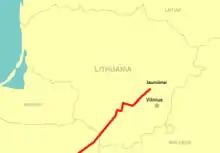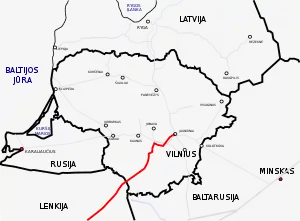Gas Interconnection Poland–Lithuania
Gas Interconnection Poland–Lithuania (GIPL) is a gas pipeline between Poland and Lithuania. Natural gas will be able to flow in both directions. The project is being implemented by gas transmission system operators AB Amber Grid (Lithuania) and Gaz-System S.A. (Poland). The construction of the gas pipeline is due to start in October 2019. It is projected that the pipeline will be ready for operation by the end of year 2021.[2] The planned length of the pipeline is 508 km (316 mi). GIPL pipeline will run from Jauniūnai Gas Compressor Station (GCS) in Lithuania to the Hołowczyce GCS on the Polish side.
| Gas Interconnection Poland–Lithuania | |
|---|---|
 Map of Gas Interconnection Poland–Lithuania | |
| Location | |
| Country | Lithuania Poland |
| Coordinates | 54°57′44″N 24°59′52″E |
| From | Hołowczyce, Poland |
| Passes through | Lithuania–Poland border |
| To | Jauniūnai, Širvintos DM, Lithuania |
| General information | |
| Type | natural gas |
| Partners | Amber Grid Gaz-System |
| Expected | end of 2021[1] |
| Technical information | |
| Length | 508 km (316 mi) |
| Maximum discharge | 2.3 billion cubic metres per annum (81×109 cu ft/a) |
| Diameter | 700 mm (28 in) |
| Compressor stations | Jauniūnai natural gas compression station |
When GIPL will be established Lithuania together with other Baltic countries and Finland will be integrated into European Union (EU) gas transmission system. The estimated value of the GIPL project is 500 million euros. The project is financed by Gaz-System and Amber Grid, and co-financed with significant grant from EU. Also part of investments in Poland is compensated by Lithuania, Latvia and Estonia.
History

Although the idea of gas interconnection between Poland and Lithuania can be traced as early as 1992,[3] more active preparatory works started in 2008–2009. Poland at that time considered other interconnection with neighbouring states and construction of LNG terminal in Swinoujscie. During these years the first study on how it would be possible to connect Polish and Lithuanian gas networks was implemented.[4]
In 2011-2013 GIPL business case analysis and feasibility study were performed. On 5 November 2014 part of GIPL project in the territory of Lithuania was recognized as an important economic project for the state. On 11 November 2014 European Commission decided to allocate to GIPL 306 million euros. [5] Before that in August 2014 Agency of Cooperation of Energy Regulators (ACER) at the request of project promoters took decision on cross-border cost allocation between Poland, Lithuania, Latvia and Estonia.
On 29 August 2015 environmental impact assessment procedures for GIPL in the territory of Lithuania were finalized.
At first, the route of GIPL was planned to connect Rembelszczyzna GCS, which is located near Warsaw, to Jauniūnai GCS, but in 2016 Poland informed Lithuania on difficulties with needed extension of Rembelszczyzna GCS and proposed an alternative routing of GIPL to connect Jauniūnai GCS with Hołowczyce GCS, which is near Belarus border. The change stipulated shorter route and lower investments into infrastructure.[6]
On 27 September 2016, all permissions for the part of the GIPL project on Lithuanian territory were obtained. In May 2018 natural gas transmission system operators of Poland, Lithuania, Latvia and Estonia signed agreement detailing the procedures on how ACER decision on GIPL cross-border cost allocation should be implemented.
In the summer of 2018 Amber Grid announced procurements for GIPL construction and gas pipes supply (in Lithuanian territory).
In 2019 June it was announced that steel pipes would be provided by Polish company Izostal.[7] In July 2019 company Alvora together with partner Šiaulių dujotiekio statyba were chosen as contractors for GIPL construction in Lithuanian territory.[8]
Technical details
The planned length of GIPL is 508 km (316 mi), the diameter of pipes is 700 mm (28 in). Gas pipeline will stretch from Jauniūnai GCS in Lithuania to Hołowczyce GCS in Poland. The length of the pipeline in Poland preliminary will amount to 343 km (213 mi), in Lithuania – to around 165 km (103 mi). The interconnection capacity from Poland to Lithuania is planned to reach 27 TWh/year or 2.4 bcm/year. From Lithuania to Poland the interconnection capacity will be 21 TWh/year or 1.9 bcm/year. The design pressure in Poland territory will be 8.4 MPa, in Lithuania territory – 5.4 MPa.
Price and financing
Altogether the price of GIPL project is planned to be around 500 million euros. In total EU is co-financing the project with 306 million euros.
According to a decision of the Agency for the Cooperation of Energy Regulators (ACER), the Baltic countries should cover 86 million euros of Poland's costs in the project. Lithuania is to pay 55 million euros of that, Latvia 29 million euros, and Estonia 1.5 million euros.
Significance
At the moment Baltic countries and Finland can only receive pipeline gas from Russia.[9] The only access to alternative gas sources and suppliers in the region is liquified natural gas import with FSRU „Independence“, which started operating in 2014, in Klaipėda, Lithuania. When GIPL is commissioned, Baltic countries and Finland will be integrated in EU gas transmission network and Baltic region will have access to more alternative gas sources with enhanced security of supply and competition.[10] It is estimated that GIPL capacities will be able to satisfy more than 40 percent of annual natural gas demand in Baltic countries and Finland.[11]
European Commission has recognized GIPL project as a Project of Common Interest (PCI).[12]
See also
LitPol Link - An electricity grid interconnection between Lithuania and Poland.
References
- Dujotiekio į Lenkiją statybų pabaiga atidėta 2,5 metų
- "Dujotiekių jungtis tarp Lenkijos ir Lietuvos (GIPL)".
- "Konsulinė konvencija tarp Lietuvos Respublikos ir Lenkijos Respublikos".
- "BEMIP iniciatyva".
- "Lenkijos ir Lietuvos dujotiekių jungties statybos finansavimui gauta išankstinė ES parama".
- "Užtruks ilgiau, gal bus pigiau: keičiama dujotiekio į Lenkiją trasa".
- "Vamzdžius Lietuvos–Lenkijos dujotiekiui tieks Lenkijos "Izostal"".
- "Lietuvos-Lenkijos dujotiekį turėtų tiesti "Alvora" su "Šiaulių dujotiekio statyba"".
- "Dujotiekio su Lenkija statyboms uždegta žalia šviesa".
- "Dujotiekio su Lenkija statyboms uždegta žalia šviesa".
- "Amber Grid GIPL".
- "First gas interconnector Poland – Lithuania ends energy isolation of the Baltic States".